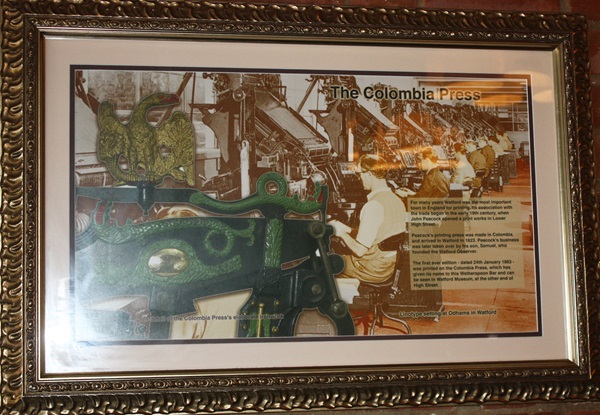This pub is closed permanently. Your nearest Wetherspoon pub: The Moon Under Water
This is named after the printing press imported from Colombia by John Peacock in 1823. During the 20th century, printing overtook brewing as Watford’s main trade. By the 1960s, thousands were employed in the industry, especially at Odhams and the Sun Engraving Company, owned by Robert Maxwell. Printing in Watford had been established in the town by John Peacock, who opened a printing works in 1820. His printing press, imported from Columbia and used to print the first edition of the Watford Observer, is in Watford Museum.
Photographs and text about The Colombia Press.

The text reads: For many years Watford was the most important town in England for printing. Its association with the trade began in the early 19th century, when John Peacock opened a print works in Lower High Street.
Peacock’s printing press was made in Colombia and arrived in Watford in 1823. Peacock’s business was later taken over by his son, Samuel, who founded the Watford Observer.
The first ever edition - dated 24 January 1863 was printed on the Colombia Press, which has given its name to this Wetherspoon Bar and can be seen in Watford Museum, at the other end of High Street.
Photographs and text about Watford Rovers.

The text reads: Watford Rovers was formed in 1881, “by a group of young lads who had been given permission to kick a football about in Cassiobury Park”. In 1898, the club joined forces with Watford St Mary’s and adopted the name Watford FC.
In 1920, the Club moved to Vicarage Road ground, where one of the main stands is named in honour of Sir Stanley Rous.
Sir Stanley was a master at Watford Grammar School for thirteen years before becoming the leading voice of English football as Secretary of the Football Association and the President of world body, FIFA. It was Sir Stanley who introduced the red and yellow card system.
If you have information on the history of this pub, then we’d like you to share it with us. Please e-mail all information to: pubhistories@jdwetherspoon.co.uk